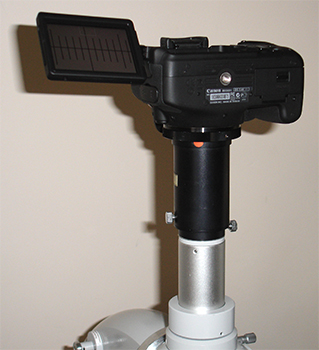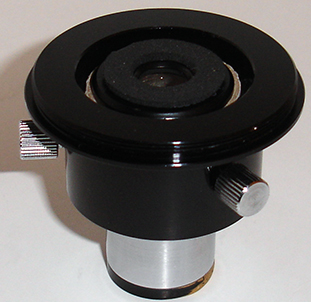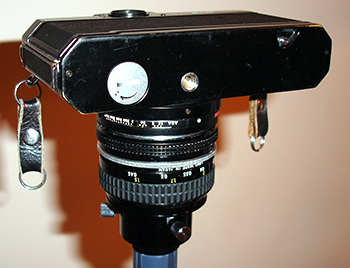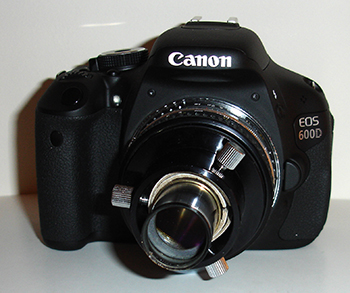I've been keen to try the afocal technique as a potential route for widening the captured field when required as some enthusiasts have reported good results with removable lens DSLRs. A recent thread in the Yahoo 'microscopes' forum highlighted a cost effective adaptor on eBay UK (seller ID 'joy8899'); it's actually sold for 1.25" telescope eyepieces but many microscope eyepieces can approach this in size, particularly modern examples or those for a stereo.
The adapter is sold in seven filter thread sizes from 28 to 58mm inclusive for £9.99. I opted for 52mm as most of my Nikkor lenses or camera adaptors have this thread. It is shown above fitted to a Zeiss Kpl 8X eyepiece and has a three point screw fixing. To bulk out the adaptor to clamp it to this or other eyepieces tried, one or two split collars of thick card from a Tesco aluminium foil roll were used. This also had the benefit of protecting the eyepiece from damage by the bare metal flat-ended screws.
The adapter potentially presents the eyepiece very close to the front element of the lens in use so also added a foam annular pad to all eyepieces tried just in case it slipped.
Fixed lens cameras that didn't work
All cameras available in the Walker household were tried, except a Sony P200 which is a small bore lens camera with no filter thread.
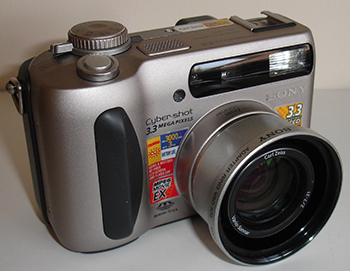
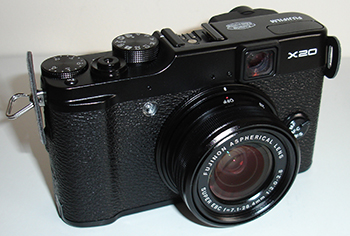
Sony S75 (left above) One of the older 3.3 Mpixel digicams but with a high quality Zeiss 3X zoom lens. I've home converted the camera to near IR only by removing the IR filter above sensor. This style of 'wider bore' fixed lens digicam I have never found easy to use on a microscope, a reversed 50mm lens or a dedicated LM-Scope adapter being best but both still give vignetting. The Sony lens adapter (shown fitted above) is for 52mm filters so suited the afocal adaptor. However, using the adapter with either a Zeiss 8X or 10X Kpl eyepiece gave marked vignetting on the microscope at all zoom levels.
Fujifilm X20 (right above) One of the new breed of Fujfilm's superbly crafted 'retro' style cameras with a very high spec. This belongs to my brother Ian and it's a delight for normal work with a fixed 28-112mm equivalent zoom lens which is fast throughout the zoom range at f2-2.8. With a new design of non-Bayer RGB array ('X-Trans CMOS II') and no anti-aliasing filter on the large (for a compact) 2/3rd inch sensor, we had high hopes for it for photomicrography.
The lens adapter which screws on lens front is for 52mm filters so was also suited to the afocal adapter to present the eyepiece (scarily) close to the front element which does not move on zooming. But despite the fast lens, wide zoom range, manual focus to try both infinity and super macro with both the Zeiss 8x and 10x Kpl eyepieces, vignetting was too severe on the microscope to be practical.
Eyepieces that were suited mechanically
Zeiss 8X Kpl (O.D. 25mm, eyepoint ca. 7mm) - two card collars (each 1mm thick) required.
Zeiss 10X Kpl W (O.D. 28mm, eyepoint ca. 20mm) - one or two card collars required.
Meiji 10X (O.D. ca. 33mm, for EMZ1 stereo) - one card collar to prevent eyepiece damage.
Eyepieces that were not suited mechanically
Leica 10X/23 (O.D. 32.3mm focussing, cat. no.10447131) - the standard eyepiece on my Leica S8 stereo. The O.D. is OK but does not extend down far enough into the adapter to be securely clamped. The eyepiece tubes are also sprung and unsuited for any weight on them.
Removable lens cameras that did work
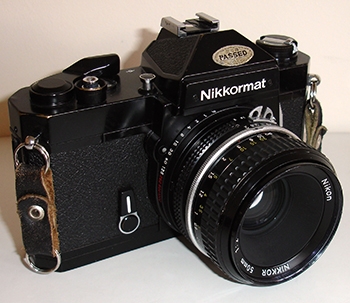
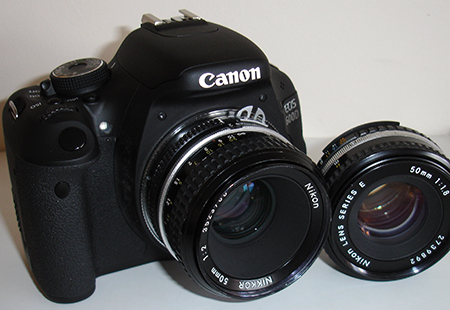
Nikkormat FT3 35mm SLR film camera (left above with Nikkor 50mm f2 lens). Potentially works. This was duly rescued from the bowels of a cupboard as it's the only full frame 35mm camera I have. I didn't run a film through it but did quickly assess with a piece of tracing paper at the film plane, shown below using the Nikkor 50mm f2 lens and the Zeiss 8X and 10X Kpl eyepieces. Vignetting on film is probably not desirable, but that present is caused by the field stop, the full field is being captured. So for a modern full frame sensor camera with way more pixels than required for resolution, perhaps it is acceptable for cropping if the image quality proves OK. The demanding micrometer as a subject looked aberration free and flat on the tracing paper but would need proper tests running film through or full frame DSLR camera to properly assess.
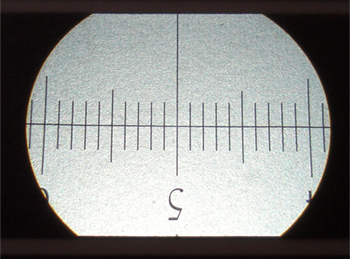

Afocal adapter with Nikkormat FT3 and Nikkor 50mm f2 AI lens. Tracing paper at film plane (paper not very flat so can distort image).
Left - Zeiss 8X Kpl. Vignetting but captures slightly wider field in x plane than full visual field in binocular head.
Right - Zeiss 10X Kpl W. Less vignetting.
As with many older 35mm film cameras this is a heavy body and with 50/2 lens weighs 920g. I wasn't very comfortable having all this weight resting on a friction three point fixing even in a vertical photo port. The unit wobbles on the small supporting area of eyepiece in a vertical tube so great care would be needed to avoid camera vibration—especially with film camera with mirror and mechanical shutter. The FT3 does have a mirror lock but the coarse viewfinder is not ideally suited for critical focus (the clear central split image does give some area for focus).
An external support using the camera bush could provide better support.
Canon 600D digital SLR, (right above). This has an APS sensor and I use with my legacy Nikkormat lenses using a Canon-Nikon adapter. The current camera used, a Canon 600D DSLR body, has Electronic First Curtain Shutter so no mechanical movement occurs at beginning of and during exposure in Live View mode. Thus the less than rigid afocal setup was not likely to be vibration prone as long as used delayed shutter release, the remote shutter or remote software control.
Best SLR lens: The textbooks note that ideally a high eyepoint eyepiece should be used and its exit pupil ideally placed at entrance pupil to the lens if the lens design permits it. Of the two tried, the Zeiss 8X Kpl has a low eyepoint at ca. 7mm, the 10X Kpl W has a high eyepoint at ca. 20mm.
The Nikkor 50mm f2 AI shown on the Nikkormat above was compared to the Nikkor Series E 50mm f1.8 (shown to right of Canon DSLR above). The former has the front element well recessed into the mount (16mm below filter flange where afocal adapter would mate), the series E's front element is only 2.5mm below the plane of filter flange. Both gave vignette free imaging with both the 8X and 10X Kpl eyepieces and good field coverage* but the series E had a noticeable hotspot in centre of image which can be tricky to remove. The 50mm f2 did not show this. (*For the two best combinations, the 50mm f2 with Zeiss 10X Kpl W and 8X Kpl eyepiece, the eyepiece exit pupil was calculated to be ca. 1mm and 12mm respectively above front element of lens.)
Other lenses tried: A Nikkor Series E 100mm f2.8. This gave marked vignetting. I do have a Nikkor Series E 75-150mm zoom lens but regarded this to be too heavy and optically complex cf. a lighter simpler designed prime lens. Many of the modern prime and zoom lenses are much lighter than the old lenses so may be worth trying if owned.
All lenses were set at infinity focus and full aperture.
Vertical eyepiece use
The camera / lens / adapter is most safely used on a vertical camera port to avoid off-axis strain. The system of choice the Canon 600D / Nikkor 50mm f2 lens was 780g and the card collars I used were not ideal with the screws needed regular checking and retightening. A stiff non-deformable plastic collar may be better.
Angled eyepiece use
I wasn't at all confident on using the adapter with either a digital or a film camera with lens on an angled eyepiece tube e.g. the Zeiss bino' head or a Meiji EMZ1 stereo bino head. The weight of the body and lens combination may strain the eyepiece tube and the card collar I used, even with screws very tight, did not reliably hold the system on axis. A stiffer and better internal padding from plastic or metal by the DIY'er may make it more suitable if the bino' head tubes are robust enough.
Examples: Displayed image used the afocal adapter with Zeiss 10X Kpl W eyepiece and Nikkor 50mm f2 lens on the Canon 600D.
Use mouseover to see the 10X Kpl W eyepiece on collar with direct projection into same camera body.
Uncropped captures, resize and slight tonal balance adjustment for each.
Zeiss 10X NA0.32 planapo. Achromatic-aplanatic condenser.
Note that tonal balances aren't directly comparable as can be adjusted to suit..
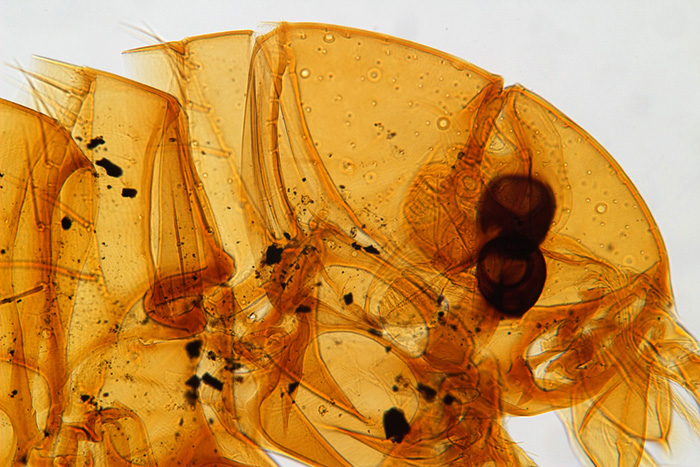
Human flea, Pulex irritans, male, unnamed Victorian slide. For the afocal setup, a good flatfield image and no obvious chromatic aberration seen in the exoskeleton to image boundary. The afocal setup had a slightly greater field of view. No obvious contrast loss for the extra optics in the afocal setup.
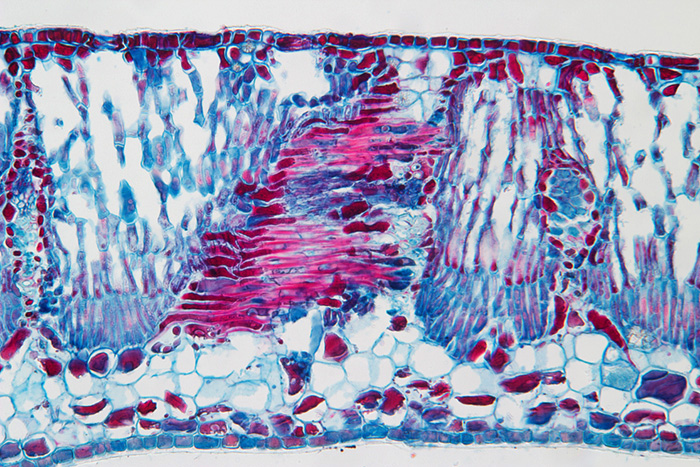
Sea grape, Coccoloba, T/S leaf. Biosil slide by the late John Wells. For the afocal setup, again a good flatfield image and no obvious chromatic aberration of the clear stem epidermis to image boundary.
Examples: Image using the afocal adapter with Zeiss 8X Kpl eyepiece and Nikkor 50mm f2 lens on the Canon 600D.
Uncropped captures, resize and slight tonal balance adjustment for each.
Zeiss 10X NA0.32 planapo. Achromatic-aplanatic condenser.

Subject as above but the field of view with the 8X Kpl was considerably better than for the Zeiss 10X Kpl W. The field is now 94% of the maximum theoretical for a 1.5:1 crop sensor fitting a circle i.e. near ideal. Flatfield image and no evidence of chromatic aberration within sensor area.
Intriguingly, the 8X Kpl on short collar was a poor projection eyepiece when used for direct projection into the camera body, with poor field of view and chromatic aberration within sensor field.
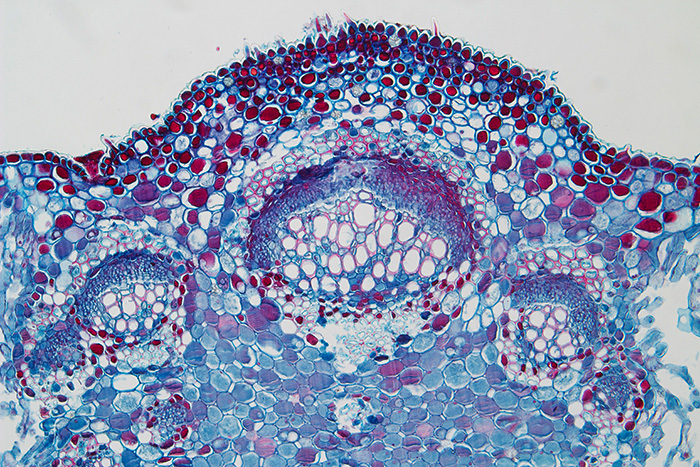
Subject as above. Again a good flatfield aberration free image with the 8X Kpl eyepiece with 50mm f2 lens.
Conclusions on my set-up
The afocal adapter is a very cost effective adapter if find a good combination as I did with the Canon APS sensor 600D DSLR / Nikkor 50mm f2 lens / Zeiss Kpl W 10X or Kpl 8X eyepiece. With the 10X eyepiece there was a useful slight increase in field of view from 66% to 75%, but for the 8X there was a valuable increase to 94% of the theoretical max. field for a 1.5:1 sensor format inscribed in the image circle over my present direct projection system at the expense of some system rigidity.
I was pleasantly surprised that the addition of a six element lens to an already 'optically busy' Zeiss Photomicroscope III gave no obvious image degradation at the normal screen image sizes (as opposed to 'pixel peeping' at or near 1:1 where the native images are poster sized.) The very fine quality of the 50mm Nikkor AI prime lens probably helped. The 8X Kpl for direct projection was a poor lens on my setup but with the 50mm Nikkor it was excellent.
I would be more wary of using the afocal adapter for film work with an old heavy camera with the present crude card collars, as did not think it was rigid enough for a mechanical shutter / mirror. Better designed internal collars for the afocal adaptor possibly tailor-made to a given eyepiece may improve this, but the camera / lens system still relies on the rigidity of an eyepiece friction fitted into an eyepiece tube. Or camera could be also externally supported via the camera tripod bush.
The afocal adapter with Nikkor 50mm f2 lens will be a useful option for image capture with my Canon 600D APS setup when the near maximum field capture is desired, but won't replace my direct projection setup which captures ca. 2/3rds of the max. field as latter gives a useful 'digital Optovar feature' for specimens that do not fill the field. I don't have a full frame DSLR to judge whether the setup also suits the larger sensor.
Afocal adapter Pros:
- very good value and well made
- with the right lens / camera / eyepiece combination, a potentially effective way of capturing a good area of visual field and with good quality
- if above satisfied, potentially save expense on a dedicated relay lens
- correct microscope eyepiece maintained to ensure full correction of microscope optics
Cons:
- design does not give the high rigidity often needed for critical work, extra care needed for vibration reduction, or use camera with electronic shutter feature
- design best suited for a vertical tube if a heavy camera body / lens combination
- three point fixings are metal and may damage microscope tube / eyepiece if firmly clamped, internal collar required
- great care needed to avoid the eyepiece slipping and damaging the front of camera lens, protection e.g. sponge pad on eyepiece advisable just in case
- (of afocal as a technique): very hit and miss, 'try it and see' only certain way of assessing if a given combination of camera / lens / eyepiece will work
Comments to the author David Walker are welcomed.
Footnote: I have no affiliation with the eBay UK seller of the adapter. Other sources of comparable adapters may be available.
Acknowledgement: Thank you to Yahoo 'microscope' forum members for drawing attention to this adapter.

